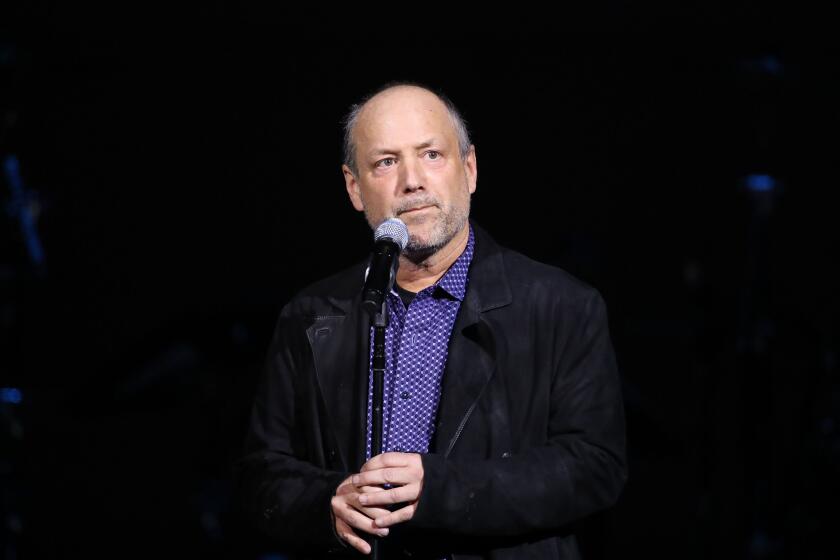Apple and Netflix and Hulu, oh my! ‘Subscription fatigue’ sets in among streamers
- Share via
Talk about too much of a good thing.
Apple’s entry into the streaming-video business Monday gives consumers another impressive choice for online movies and TV shows — a high-profile, deep-pocketed competitor for the likes of Netflix, Amazon and Hulu.
It also is sure to prompt some people to rethink which services they want to keep paying for.
“Consumers may be entering a time of subscription fatigue,” said Kevin Westcott, vice chairman of the consulting firm Deloitte, which last week released its latest Digital Media Trends survey highlighting industry developments.
It found that 47% of streaming-video subscribers feel there are too many services, too many choices, too many ads and too many monthly fees.
Westcott said that as media companies jockey for streaming-video market share, they also need to “keep a close eye on consumer frustrations, including advertising overload and data privacy concerns.”
Apple’s service, dubbed Apple TV+, arrives as the streaming-video market marks a major milestone: For the first time, there are more subscriptions to streaming services than there are subscriptions to traditional pay-TV services such as cable and satellite.
This is a very big deal, signaling an irreversible shift away from the fat bundles of channels that once defined the pay-TV industry and the arrival of a new business model focused on narrower programming choices.
It’s also an example of being careful about what you wish for.
For years I’ve been pounding the drum for a la carte TV — allowing consumers to pay only for the channels they want, rather than hundreds they don’t want.
Streaming video isn’t that. But it’s closer. And now cord cutters have choices to make.
A report Monday from CompareCards.com, a credit card comparison site, found that people with online subscriptions spend an average of $38 a month. Apple hasn’t revealed how much its service will cost, but it seems sure to drive that total higher.
The Deloitte report, meanwhile, makes clear (and my own experience as a cord cutter backs up) that it’s just not feasible to subscribe to everything.
Some other takeaways from the Deloitte report:
- While 65% of people have a traditional pay-TV service, 69% have at least one streaming-video subscription.
- The typical streaming-video subscriber pays for three services.
- Consumers will choose a particular streaming service based primarily on the movies and shows available. Fifty-seven percent of consumers overall said they seek out original content. Seventy-one percent of millennials said original content is king.
Apple TV+ will pull together content from a variety of providers, including, at an added cost, HBO and other premium channels, and offer recommendations based on your viewing habits. It also will feature original content, including a resurrected “Amazing Stories” anthology series from Steven Spielberg.
While pricing remains a question mark, Apple said Monday the service will be ad-free and available on demand. Importantly, Apple TV+ will be accessible beyond the Apple ecosystem, meaning you’ll be able to see it via a Roku or Fire TV streaming device.
Apple also unveiled an expanded news app called Apple News+, costing $9.99 monthly. The Los Angeles Times is part of the mix.
All these developments — the Apple streaming service, the changes revealed in the Deloitte report — are hugely important, indicating that people have more control over their TV viewing than ever before, despite decades of resistance from pay-TV companies determined to maintain their bloated profit margins.
But this notion of “subscription fatigue” is real and suggests that an industry shakeout is coming.
Deloitte says consumers now have more than 300 streaming-video services to choose from. The vast majority are small, specialized services such as Fandor, which charges $10 a month for access to independent or hard-to-find movies.
The big guys — Netflix, Amazon, YouTube, HBO, etc. — vary in price for high-definition streaming from about $12 to $40 monthly and provide lots of viewing options. A gotta-have-it Disney streaming service is coming soon.
Each counts on original or exclusive content to attract subscribers, which means someone who wants access to all the shows and movies people are talking about can easily spend well over $100 a month on streaming subscriptions.
And suddenly we’re back where we started, with monstrous monthly bills for tons of content we may never view.
“Consumers are tiring of the friction of managing multiple subscriptions and the hassles that come with it,” the Deloitte report concludes. “This friction will likely rise as more networks and studios go direct with their own streaming services, pulling content from rivals and fragmenting the market.
“Costs for content may go up, and if they do, consumers and services lacking critical mass may put pressure on the industry to reaggregate.”
That’s the next phase of pay TV’s evolution. The various streaming services will struggle for audience and dominance. Ideally, this level of competition would push prices down, but don’t hold your breath.
The investments being made in original content mean subscription fees likely will keep growing. Last fall, Netflix said it planned to borrow $2 billion more to cover its increasing production costs, adding to nearly $12 billion in existing debt.
In January, the company said it was raising monthly fees by as much as 18%.
The fact that Netflix movies earned 15 Academy Award nominations this year and took home four Oscars tells you the big streamers are in it to win it.
I imagine that instead of three or four big TV networks, we’ll end up with three or four big streaming services, and content that’s now on niche services will be absorbed by the industry leaders or disappear.
At the same time, all this streaming will create ever-stronger demand for broadband internet access, which means the top providers such as Charter/Spectrum, Comcast, AT&T and Frontier Communications will keep jacking up prices.
They’ll say (as they already do) that frequent rate hikes are needed to cover network improvements. The reality is that as the companies earn less and less from traditional pay-TV plans, they’ll increasingly rely on internet service as the primary money spinner keeping shareholders happy.
Stir all this together and you get an industry that resisted change for as long as it could, and when it had no choice, it adapted quickly to the new digital landscape.
And then it started running the same old playbook to lock in viewers and charge them as much as it can get away with.
I cut the cable cord several years ago. I now pay Spectrum $66 a month for internet service, which is about twice what it cost when I signed up. And, like most people, I have several streaming services to choose from, costing an additional $50 or so monthly.
I have no doubt that these combined costs will reach $200 a month within the next few years.
There’s little we can do about subscription fees, other than to be more selective about which streaming services we sign up for and hope a competitive market works its magic.
Broadband internet costs — that’s a whole other matter.
I’m with those who say high-speed internet should be treated like any other utility, particularly in light of the fact that a single company is often the sole provider for thousands of households.
Broadband should be regulated to ensure high-quality service at reasonable prices, with all rate hikes requiring justification and documentation by providers.
We didn’t bat an eye when that sort of thinking applied to phone service.
Are things so different now?
Maybe we won’t get to a la carte TV any time soon. But that doesn’t mean we should submit to being fleeced just to binge-watch our favorite shows.
David Lazarus’ column runs Tuesdays and Fridays. He also can be seen daily on KTLA-TV Channel 5 and followed on Twitter @Davidlaz. Send your tips or feedback to david.lazarus@latimes.com.
More to Read
Inside the business of entertainment
The Wide Shot brings you news, analysis and insights on everything from streaming wars to production — and what it all means for the future.
You may occasionally receive promotional content from the Los Angeles Times.











